As the snow melts away, Montana’s landscapes transform into a vibrant tapestry of colors. The once-white meadows burst with life, showcasing nature’s beauty in full bloom. This time of year feels like a fresh start—a chance to reconnect with the outdoors and witness the magic of wildflowers.
From the alpine meadows of Glacier National Park to the golden slopes of the Columbia River Gorge, diverse ecosystems come alive. Each trail offers a unique experience. Imagine spotting rare Oregon silverspot butterflies fluttering among coastal blooms or hiking through fields of balsamroot and lupines. It’s a feast for the senses.
This season is more than just a visual delight—it’s an invitation to explore and rejuvenate. Whether you’re a seasoned hiker or a casual nature lover, these trails promise unforgettable moments. Ready to plan your adventure? Check out these spring wildflower hikes in the Pacific for inspiration.
Key Takeaways
- Montana’s snowy landscapes transform into vibrant wildflower meadows.
- Glacier National Park and Columbia River Gorge offer diverse ecosystems.
- Spot rare Oregon silverspot butterflies in coastal blooms.
- Trails like Dalles Mountain Ranch provide unique floral displays.
- Bloom times vary by elevation, temperature, and sunlight.
Introduction: Embrace the Beauty of Spring Wildflowers
The first signs of warmth bring Montana’s meadows to life with a kaleidoscope of colors. Dewy grasses glisten under the morning sun, while pasque flowers and prairie smoke dot the landscape. It’s a sensory experience—the earthy scent of damp soil, the gentle rustle of leaves, and the vibrant hues of lupines and Indian paintbrushes.
I’ll never forget the first time I stumbled upon trillium blooms in the Smoky Mountains. Their delicate white petals seemed almost magical against the lush green backdrop. In contrast, the bold golden blankets of balsamroot in the West are a sight to behold. Each region offers its own unique floral display, a testament to the diversity of nature.
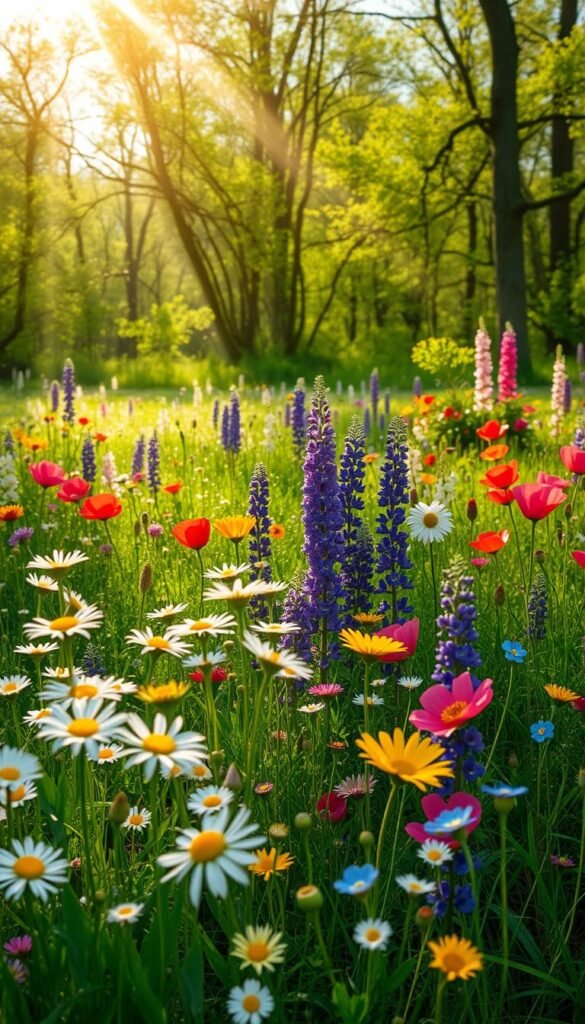
Beyond their visual appeal, these blossoms play a crucial role in supporting pollinators and entire ecosystems. Bees, butterflies, and birds rely on them for sustenance, making wildflowers a vital part of the natural world. As we explore these trails, we’re not just witnessing beauty—we’re connecting with the intricate web of life.
Curious about when and where to catch these blooms at their peak? Stay tuned as we dive into the details of bloom times across different regions and elevations. Your next adventure awaits!
Top Wildflower Trails in the United States
Across the U.S., nature paints its canvas with vibrant blooms every year. From towering mountains to rolling prairies, each trail offers a unique glimpse into the beauty of flowers. Whether you’re seeking a challenging hike or a peaceful stroll, these destinations promise unforgettable experiences.
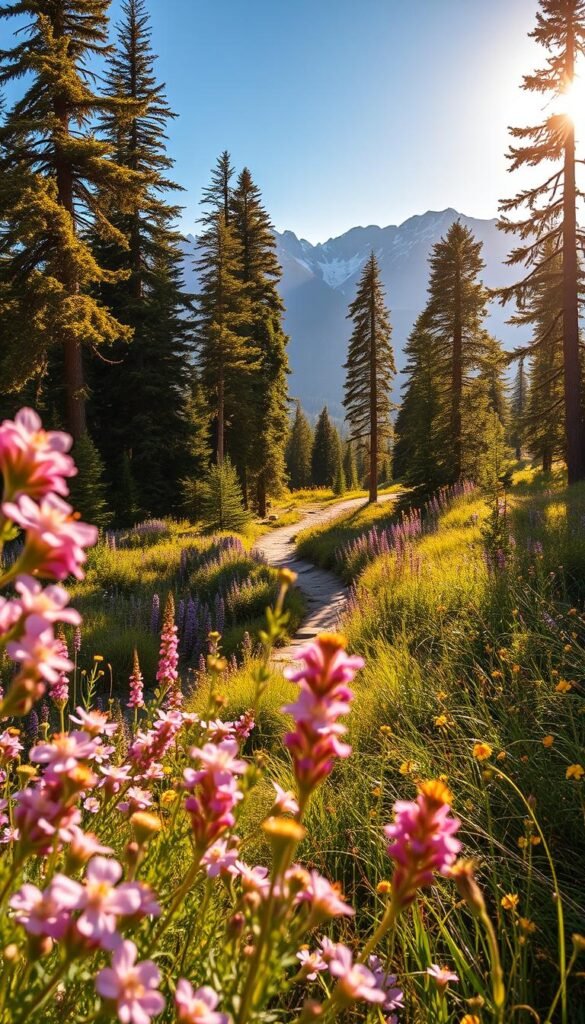
Glacier National Park, Montana
Glacier National Park is a paradise for flower enthusiasts. The Going-to-the-Sun Road showcases a progression of blooms from April to July. Early in the season, pasque flowers and glacier lilies dot the landscape. By mid-summer, lupines and Indian paintbrushes take center stage.
Bridger Mountains, Montana
For early-season blooms, the Bridger Mountains are a must-visit. I recommend using Hatch Adventures trucks to access trailheads. The views of the surrounding valleys are breathtaking, especially when paired with the vibrant wildflowers.
Porters Creek Trail, Great Smoky Mountains National Park, Tennessee
This trail winds through an old-growth forest, offering a serene setting for delicate spring ephemerals. In April, white trillium and fringed phacelia create a magical carpet of blooms. It’s a perfect spot for a peaceful escape.
Dog Mountain, Columbia River Gorge, Washington
Dog Mountain is known for its steep 3,000-foot elevation gain, but the reward is worth it. In May, balsamroot blooms blanket the hillsides, offering stunning views of the Columbia River. Be prepared for a challenging but rewarding hike.
Alpine Pond Nature Trail, Cedar Breaks National Monument, Utah
Late June to July brings a burst of color to this trail. The volcanic formations provide a dramatic backdrop for the vibrant flowers. Don’t miss the 20th annual Cedar Breaks Wildflower Festival for guided tours and educational programs.
Scenic Overlook to Davis Trail, Tallgrass Prairie National Preserve, Kansas
This never-plowed prairie ecosystem is home to unique flora. From July to August, prairie sunflowers and goldenrod dominate the landscape. The endless sea of grass and blooms is a sight to behold.
Four Lakes Loop, Trinity Alps Wilderness, California
For high-altitude blooms, the Four Lakes Loop is unmatched. In September, gentians add a splash of blue to the alpine meadows. Consider converting this day hike into an 18.4-mile backpacking route for a more immersive experience.
| Trail | Location | Peak Bloom | Highlight |
|---|---|---|---|
| Glacier National Park | Montana | April-July | Going-to-the-Sun Road |
| Bridger Mountains | Montana | Early Season | Hatch Adventures trucks |
| Porters Creek Trail | Tennessee | April | Old-growth forest |
| Dog Mountain | Washington | May | Columbia River views |
| Alpine Pond Nature Trail | Utah | Late June-July | Volcanic formations |
| Scenic Overlook to Davis Trail | Kansas | July-August | Prairie sunflowers |
| Four Lakes Loop | California | September | High-altitude gentians |
Best Times to Visit Wildflower Trails
Timing is everything when it comes to witnessing nature’s floral masterpiece. The season and region play a huge role in determining when plants burst into color. For example, in the Smokies, April is prime time for peak blooms, while the Columbia Gorge dazzles in early to mid-May.
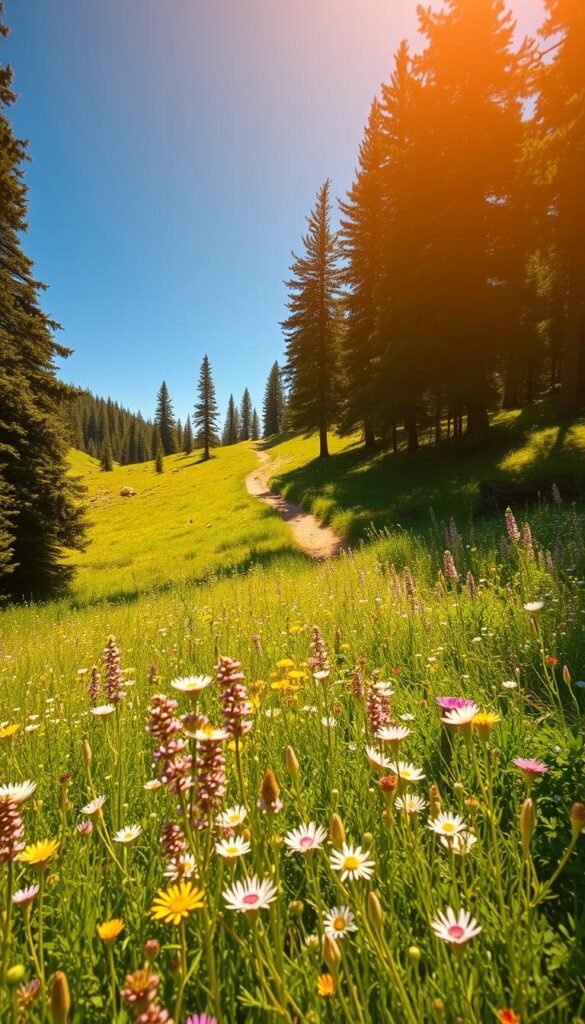
Elevation also shapes bloom schedules. In Glacier National Park, lower elevations see flowers as early as April, while higher areas don’t peak until July. Coastal areas like Lincoln City bloom earlier than mountain regions like the Cascades due to milder temperatures.
Here’s a quick cheat sheet for different regions:
- Smoky Mountains: April
- Columbia Gorge: Early to mid-May
- Cedar Breaks: Late June to early July
- Tallgrass Prairie: July to August
- Trinity Alps: September
Climate change is altering traditional bloom calendars. Warmer winters and shifting weather patterns mean some flowers appear earlier or later than expected. Staying updated with resources like Montana Fish, Wildlife & Parks can help you plan your trip more effectively.
Whether you’re chasing coastal lupines or alpine gentians, understanding bloom times ensures you don’t miss nature’s most vibrant displays. Plan wisely, and you’ll be rewarded with unforgettable blooms.
Tips for a Successful Wildflower Hike
Embarking on a wildflower hike is more than just a walk—it’s an immersive experience in nature’s artistry. To make the most of your adventure, a little preparation and mindfulness go a long way. Here are some tips to ensure your hike is both enjoyable and respectful of the environment.
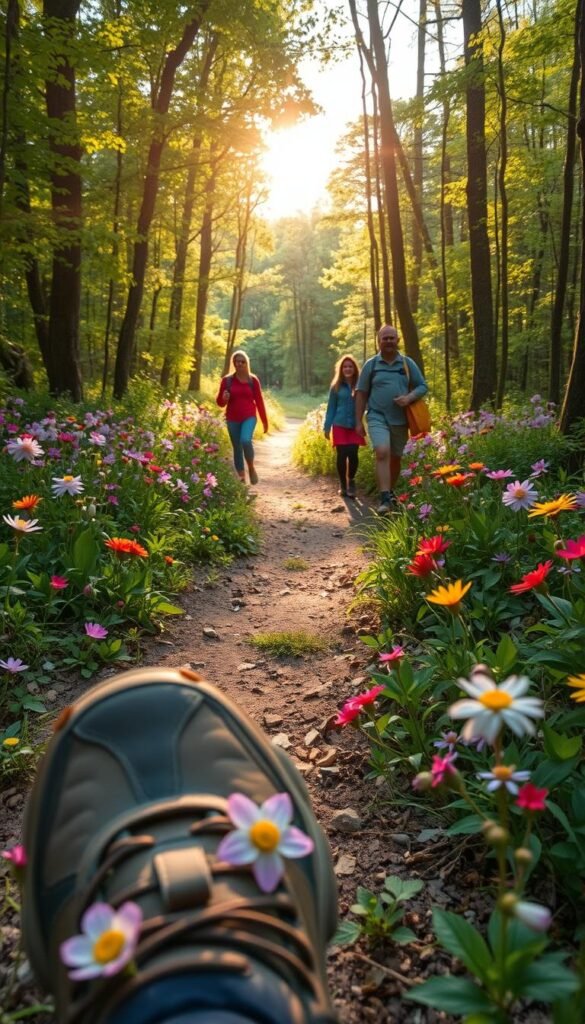
Plan Ahead
Start by checking the Montana Fish, Wildlife & Parks website for updates on bloom conditions and trail accessibility. I always rely on Gaia GPS for detailed trail maps and bloom tracking. Unexpected snow patches on high-elevation trails can surprise even seasoned hikers, so be prepared for changing conditions.
Respect Nature
When photographing delicate plants, practice proper etiquette—avoid trampling or picking flowers. Remember, these blooms are part of a fragile habitat that supports pollinators and wildlife. Join initiatives like Lincoln City’s SOLVE Earth Day Cleanup to give back to the trails you enjoy.
Pack Essentials
Bring a macro lens for stunning close-ups and a field guide to identify different species. Don’t forget essentials like water, snacks, and layers for unpredictable weather. Most importantly, follow leave trace principles—pack out all trash and leave the trail as pristine as you found it.
By planning ahead, respecting nature, and packing smart, you’ll create lasting memories while preserving these beautiful landscapes for future visitors. Happy hiking!
Photographing Wildflowers: Tips and Techniques
Capturing the delicate beauty of wildflowers requires patience and the right techniques. Whether you’re a seasoned photographer or a beginner, these tips will help you create stunning images that showcase nature’s artistry.
Morning light is your best friend. The soft, golden hues of dawn highlight dew-kissed petals, adding a magical touch to your shots. I’ve found that Cedar Breaks’ diverse backdrops—volcanic formations and alpine meadows—provide the perfect setting for vibrant compositions.
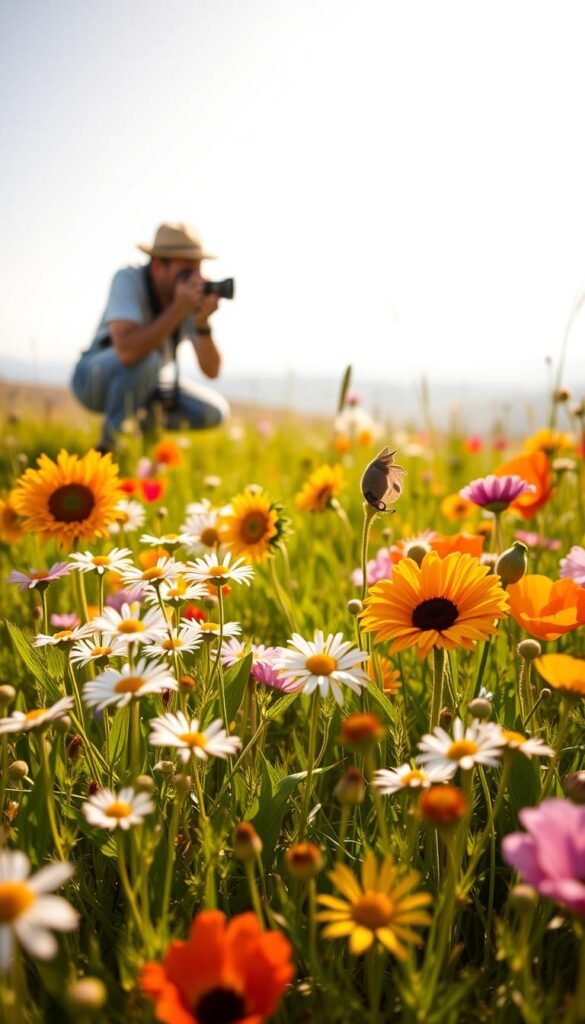
For close-ups, macro photography reveals intricate details that often go unnoticed. Focus on the delicate veins of a lily or the tiny hairs on a stem. Use prairie grasses as natural framing elements to add depth and context to your images.
Ethical practices are crucial. Never pick flowers or disturb the soil for a better shot. These plants are part of a fragile ecosystem that supports pollinators and wildlife. Respecting the nature you’re capturing ensures it remains pristine for future visitors.
Finally, invest in lightweight gear. A tripod stabilizes your camera, while a polarizing filter enhances colors and reduces glare. With these techniques, you’ll not only capture stunning views but also create lasting memories of your wildflower adventures.
Wildlife Encounters on Wildflower Trails
Wildflower trails are not just about the flowers—they’re a gateway to wildlife encounters. From pollinators to grazers, these trails are alive with activity. Every step brings you closer to the intricate web of life.
Bees, butterflies, and birds rely on blooms for sustenance, creating a symbiotic relationship. In Yellowstone, I once spotted a grizzly bear grazing on lush vegetation near a meadow of lupines. It was a reminder of how interconnected these ecosystems are.
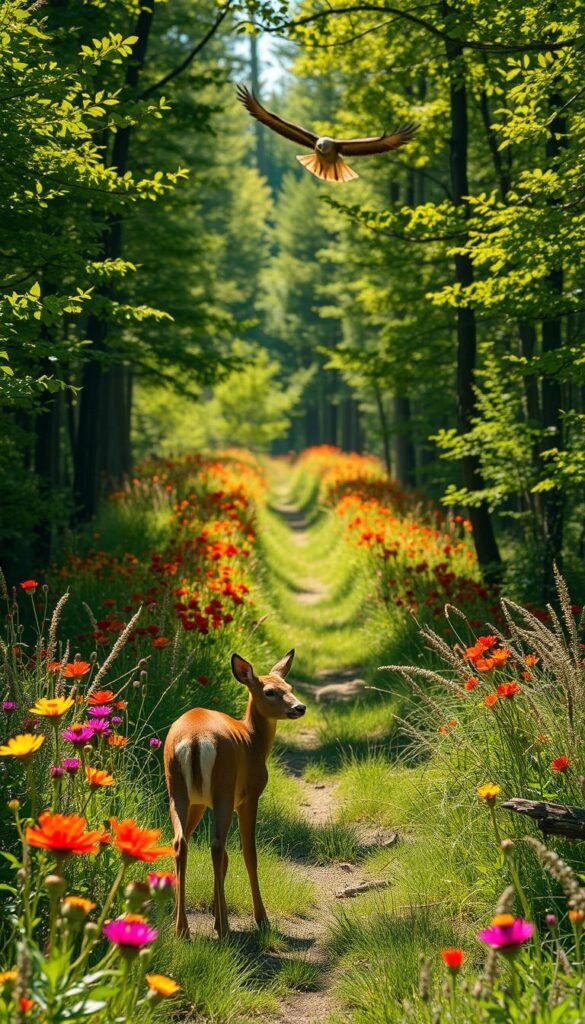
Safety is crucial in bear country. Always carry bear spray, hike in groups, and make noise to avoid surprising wildlife. In Montana parks, these protocols ensure both your safety and the animals’ well-being.
For coastal adventures, Lincoln City’s seal pups are a delight. Observe them from a distance to avoid disturbing their habitat. I’ll never forget the sight of a mother seal nursing her pup among the dunes—a truly unforgettable experience.
One of my most memorable moments was encountering a herd of elk among Beargrass blooms in Glacier National Park. The towering flowers framed the scene perfectly, creating a picture-perfect memory.
For those who love citizen science, apps like iNaturalist are invaluable. They allow you to document sightings and contribute to wildlife research. Here’s a quick guide to some of the best tracking tools:
| App | Features | Best For |
|---|---|---|
| iNaturalist | Species identification, community sharing | All wildlife |
| eBird | Bird tracking, migration patterns | Birdwatchers |
| Seek by iNaturalist | Instant ID, offline use | Beginners |
Responsible practices ensure these habitats remain pristine for every visitor. Whether you’re tracking gray whales during their migration or spotting elk in the meadows, these trails offer a unique glimpse into nature’s wonders.
Exploring Wildflower Trails with Family
Lincoln City’s unique trails make hiking with kids an unforgettable adventure. From treasure hunts to educational games, these paths offer a perfect way to bond with loved ones while enjoying nature’s beauty.
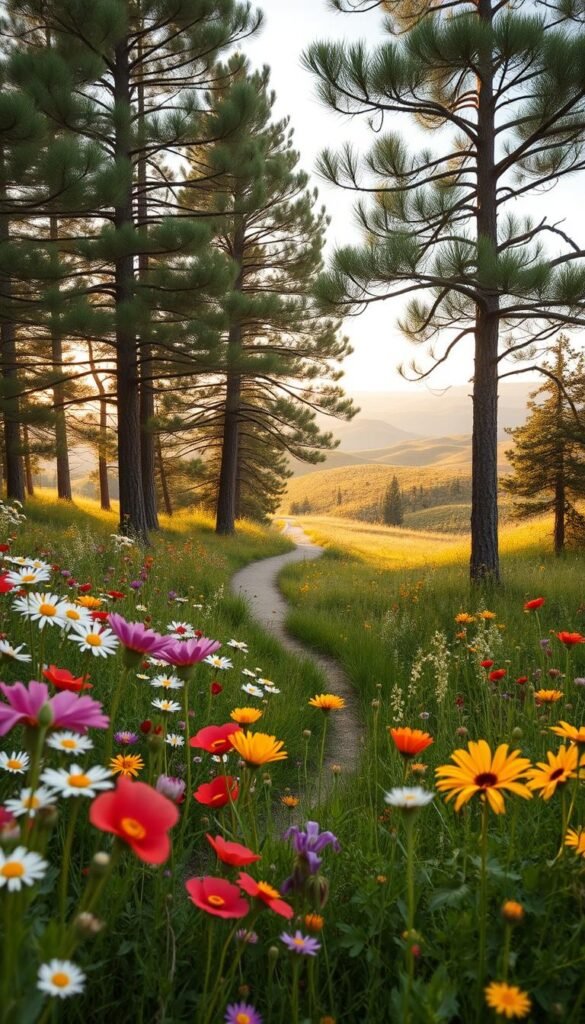
One standout is the 135-foot “world’s shortest trail.” It’s ideal for little legs and introduces young visitors to the joy of hiking. Pair it with the Finders Keepers glass float hunt, and you’ve got a day full of excitement.
For educational fun, try wildflower bingo. Kids can spot blooms like lupines and Indian paintbrushes while learning about local flora. It’s a creative way to keep them engaged and curious.
Accessibility is key for family outings. The Connie Hansen Garden offers ADA-friendly paths, ensuring everyone can enjoy the experience. Its serene setting is perfect for multi-generational hikes.
When hiking with young children, pack smart. Bring lightweight carriers, snacks, and extra layers. I’ve found that a small backpack with essentials makes the journey smoother for everyone.
One of my favorite memories is a multi-generational hike in the Bridger Mountains. Watching my grandparents share stories with my kids while surrounded by vibrant blooms was priceless. It’s moments like these that make family hikes so special.
| Trail Name | Features | Best For |
|---|---|---|
| Lincoln City’s Short Trail | 135-foot path, treasure hunt | Young kids |
| Connie Hansen Garden | ADA-accessible, serene setting | Multi-generational groups |
| Bridger Mountains | Vibrant blooms, family-friendly | All ages |
Whether you’re chasing treasure or spotting blooms, these trails create memories that last a lifetime. Plan your next family hike and discover the magic of nature together.
Conclusion: Your Spring Wildflower Adventure Awaits
There’s something magical about stepping into a meadow painted with nature’s finest hues. This season offers a unique way to reconnect with the outdoors and witness its transformative beauty. Whether you’re chasing blooms or capturing memories, every moment feels like an adventure.
Share your sightings through platforms like iNaturalist or park journals. Your contributions help others discover these hidden gems. Remember, safety is key—mountain weather can change quickly, so always be prepared.
Combine your love for nature with Lincoln City’s Finders Keepers festival for an unforgettable experience. As the sun sets over an alpine meadow awash in paintbrush red, you’ll feel a deep connection to the land. Leave no trace, and let these landscapes inspire you for years to come.
For more insights on the wonders of wildflowers, check out this guide. Your next adventure awaits—step into the beauty of the outdoors and let it transform you.
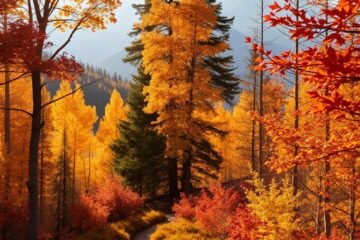
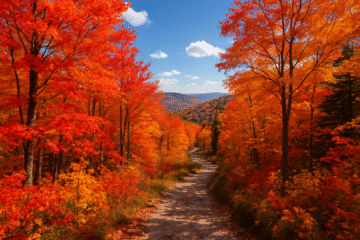
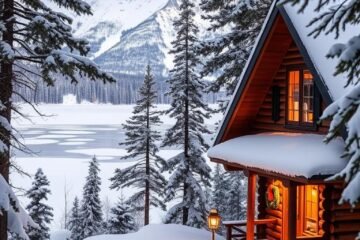
0 Comments